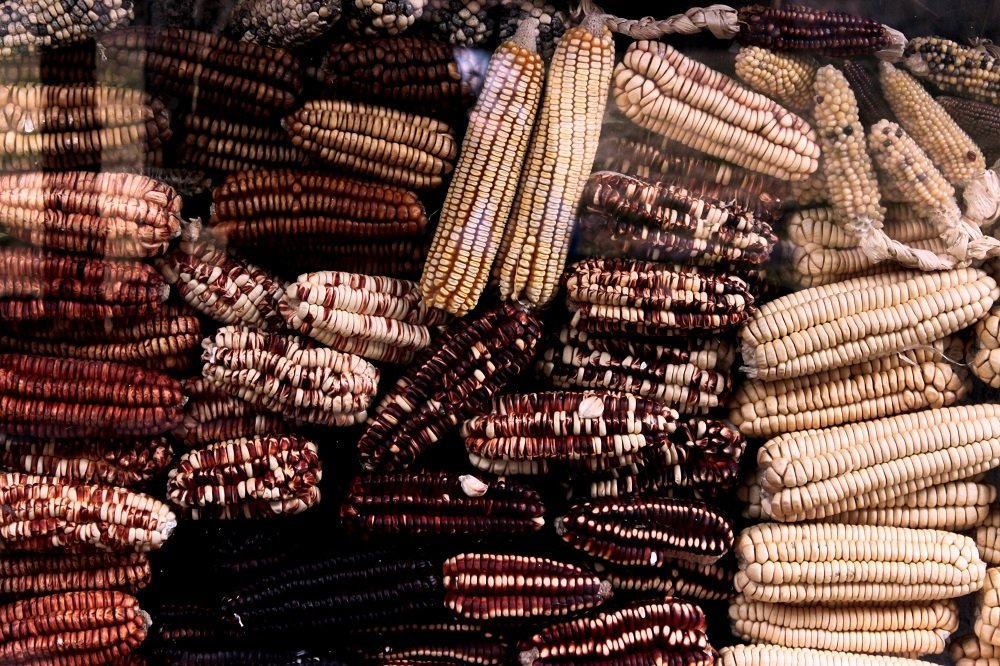Business
Farmers’ report: What’s changed over the past week?
Corn closed higher last week. The weekly charts imply that higher prices are possible over the next few months.

Weekly report with detailed analysis and commentary on the state of agriculture markets in the U.S.
Wheat
US markets were high for the week. Futures markets are showing a sideways pattern after rejecting a new leg lower several weeks ago. There is a good chance that futures have seen some longer-term lows, but for now, it is hard to imagine that the market has much upside potential. US markets started to move higher in reaction to the Egyptian tender results at the middle of the week. The US did not sell Wheat at the tender, the sales went to eastern Europe and Russia. However, prices paid by Egypt increased and this increase in price gave the US price a chance to turn firmer. There is little selling interest noted from US producers. Current prices would provide losses for them. The market has made it to the new year and the trade is starting to look ahead to the January reports from USDA. A big question will be the US planted area.
We expect US planted area to drop again this year and that total planted area to Winter Wheat could be the smallest in decades. It has been a loser for producers so many have shifted to row crops or something else in hopes of finding a profit. The freeze event in the US last month implies the potential for yield loss on some of the planted area, so it is possible that the US crop in 2017 will be smaller than last year and the smallest in many years. That means that the downside potential for Wheat should be limited until more is known about the crops this Spring. However, the US still needs to sell Wheat in the world market, so that means limited upside for now. We look for a range trade to continue through the next few months with a bias to higher prices.

Weekly Chicago Wheat Futures © Jack Scoville

Weekly Kansas City Wheat Futures © Jack Scoville

Weekly Minneapolis Wheat Futures © Jack Scoville
Corn
Corn closed higher last week. The weekly charts imply that higher prices are possible over the next few months. The USDA export sales report was positive and sales and shipments remain above year-ago levels. US farmers are not really offering in the cash market, and basis levels in the country have held firm. Gulf of Mexico basis levels have been stable in the past week. US sales remain strong as the competition has been reduced. Ukraine has been offering and has been selling along with the US, but some analysts feel that Ukraine will soon run out of exportable supplies. That could leave the US as the best offer in the world market. There is some talk that Brazil and Argentina will now start to offer Corn in competition with the US into the world market.
However, sales from South America could be limited for several more months. Brazil was very short Corn in its domestic cash market for most of the last year as the exporters oversold. Brazil had to import most of the Argentine Corn surplus and prices in its domestic markets remain high. It seems most likely that the first part of the Corn harvest in both countries will go to fill internal pipelines and exports will become possible once the local pipelines are filled. The market knows that US farmers have been storing Corn in hopes of stronger prices, and it knows that sooner or later some of the crop will need to get sold. Buyers will only try to bid the market higher to the point that demand gets covered, then prices will drop again. The threat of selling from US producers will limit the upside for now, but there are still good chances for the market to move higher and close to $3.75 to perhaps $4.00 per bushel.

Weekly Corn Futures © Jack Scoville

Weekly Oats Futures © Jack Scoville
Soybeans and soybean meal
Soybeans and Soybean Meal were higher for the week as questions about the weather in South America continued. Rains began to appear in Argentina a week ago and were reported again late last week and over the holidays. Some of the rains have been heavy and some flooding has been reported in central Argentina. The crops in Argentina should be in much better condition except in the flooded areas, due to the increased rainfall as some areas of the country had seen very little. Southern Brazil had also been drier than normal and has now been getting some beneficial rains. The area to watch will be northern Brazil as northeast areas especially turn hot and dry. Central areas are also turning warmer and drier, with some areas seeing high temperatures near 100F. The market is also hearing about some initial harvest activity in the far north of Mato Grosso.
This is a very early start to the harvest. Most northern Mato Grosso areas will not start until later next month and Soybeans could be available for export by late February or early March. The trade fears lost business for the US once Brazil starts selling. However, the uncertain economy and currency in Brazil are making farmers take a wait and see attitude. The farmers fear Real weakness and want to wait and see if they are right before selling as Soybeans become a bank for them.
Farmers in southern Brazil are done with planting, but Argentina still has more to go and will no finish until the middle of the month. US farmers are selling Soybeans and reports indicate that much of the crop has been sold. US farmers are looking at futures price indications for next year and Soybeans right now are presenting the better return. A sharp increase in Soybeans planted area is possible in 2017. A choppy and sideways trade is expected for now, but many analysts expect prices to work lower as the year moves on as long as the production is strong in South America and the US planted area increases significantly.

Weekly Chicago Soybeans Futures

Weekly Chicago Soybean Meal Futures © Jack Scoville
Rice
World markets were mostly stable again last week. Southeast Asian prices were called unchanged all week. US futures markets moved a little higher, with most of the move coming on Friday. Short speculators were forced to cover as January deliveries were much less than expected and as export sales reports from USDA were strong. Short and medium term trends remain down in Chicago. The US market remains very quiet for the holiday period. Most producers will now start to look at prices and try to find a way to make a profit on the crop grown last year. Prices at this time as cash market bids remain well below the cost of production for most sellers.
Domestic mills appear to have enough Rice in hand to meet projected demand into next year. Philippines is telling its Rice producers to be prepared for a more open market next year as it must make moves to comply with WTO deals. The more open market could mean increased access to cheaper Rice from places like Vietnam and Thailand, and the government is very worried that its own farmers, who use old methods and produce smaller yielding crops, will get hurt. It is looking for ways to support domestic production and is considering GMO and other technology aids for producers. The US is facing a big cut in planted area next year unless prices improve this Winter. Planting mix decisions will start being made this month, and most are now expecting a drop of 15% to 25% in planted area due to price. It just is not profitable to grow Rice in the US at current prices.

Weekly Chicago Rice Futures © Jack Scoville
Palm oil and vegetable oils
World vegetable oils markets showed mixed trends last week. Palm oil prices were firm, but soybean oil prices were slightly lower. Production of palm oil might be down, but. Demand for vegetable oils has been good, but not great. The export volumes have been dropping in Malaysia on a month to month basis as palm oil is currently very high priced. Soybean oil has seen some improved sales, but supplies are very good as well. Soybean oil is also getting hurt as the US biofuels credit has now expired and will not be renewed by the new administration. Palm oil sales have suffered to traditional customers like China and India. The reduced sales pace partially reflects the smaller crops produced in the last six months due to the drought losses from El Nino.
The smaller palm oil production has pushed palm oil prices to points where it makes sense for buyers to consider soybean oil. Chart patterns have turned mixed in the last couple of weeks. Palm oil appears ready to continue the recent strong rally with a break above 3300 Ringgit per ton. However, soybean oil charts are not so strong. Soybean oil currently is testing support at about 34.00 cents per pound and this support might hold. Holding now could mean that world vegetable oils prices will post a strong quarter in terms of prices. The key to market direction should be known within the next couple of weeks.

Weekly Malaysian Palm Oil Futures © Jack Scoville

Weekly Chicago Soybean Oil Futures © Jack Scoville

Weekly Canola Futures © Jack Scoville
Cotton
Futures were higher last week. The weekly charts show that the market held support and that the longer-term uptrend remains intact. The market is testing the up trend line and needs to hold at current levels. Significant long liquidation is possible if the market does not hold. On the other hand, the short term down trend line has been broken with the price action last week, so the path of least resistance appears to be up. Speculators are the major longs and this fact could create some down side price risk. The news for cotton has been favorable for higher prices. USDA weekly export sales were very strong and were a reason for the market to rally sharply in the first half of the day on Friday. More strong weeks of sales are expected as there are limited cash market offers in the world market.
The situation in India remains difficult as the market has yet to open much due to the changes in monetization of the country. The government has changed bills and appears to be forcing more electronic transactions to open the economy and increase transparency. Trade in most agricultural markets has ground to a halt for a while and is now slowly starting to get better. The US has been able to sell more cotton into the world market this year due to these developments, and even Pakistan has become a good buyer as they look to replace purchases normally made from India. The US should remain a strong seller for the next few months and the longer term sideways to up trend should remain intact.

Weekly US Cotton Futures © Jack Scoville
Frozen concentrated orange juice and citrus
FCOJ closed higher on Friday and higher for the week. The market is looking at stable production estimates for Florida and the potential for increased competition from Brazil. USDA left production estimates for Florida oranges unchanged in its monthly reports last month, and will probably leave them unchanged again in the next round of reports next week. There are no frosts or freezes in the forecast for Florida as temperatures remain warm. It has been dry, and producers have been forced to irrigate frequently. Less Florida production and also less production in Brazil are the main market support factors.
Brazil also suffers from the greening disease but is expecting a sharp recovery from the drought-induced production losses of last year. That would put production near the historical normal and alleviate many concerns about the reduced Florida production as the Brazil production will be available for import and blending. The Florida harvest is moving forward, but harvest progress has been slow and progress is called behind normal. Fruit is moving to packing houses for the fresh trade and is also now moving to processors. In Brazil, Sao Paulo state is getting good weather and crop conditions are called good. However, the production area has turned drier and trees could soon show signs of stress.

Weekly FCOJ Futures © Jack Scoville
Coffee
Futures moved higher last week, with London once again the stronger market. New York prices are getting close to support areas on the weekly charts, so down side potential might also be limited after several weeks of falling values. This could be especially true if London can stay strong and trade higher. The offer side of the market is quiet, but interested in selling rallies. Differentials paid in Central America appear stable at weak levels. Little selling is being reported, but offers are available as the harvest is active.
Differentials are also stable in Colombia. Brazilian producers have become quiet as the fear further weakness in the Real against the US Dollar. Differentials have turned stronger in the past week in an effort to encourage new sales. Coffee becomes a bank account when these fears get big enough. Roasters have become more withdrawn in the marketplace due to the recent surge in prices, and now due to the price weakness. They will probably start to buy again if a more stable price outlook appears.

Weekly New York Arabica Coffee Futures © Jack Scoville

Weekly London Robusta Coffee Futures © Jack Scoville
Sugar
Futures closed higher last week in recovery trading. The weekly charts show that New York futures might struggle with further rallies in the short term. It is possible that futures eventually move down to test more support at 1600 and 1500 in New York. Price action overall remains negative on worries about overall demand potential and on bigger than expected exports from Brazil. Demand news remains bearish for futures prices. China has imported significantly less Sugar in the last couple of months as it starts to liquidate massive supplies in government storage by selling them into the local cash market.
The Brazilian market got jolted by the UNICA reports of less production in the last reporting period. That was a surprise to the market and did a lot to offset demand worries for the short term. There could be smaller crops coming from India and Thailand due to uneven monsoon rainfall in Sugar areas in both countries. India has said that its production and amounts in storage are sufficient and that there is no need for imports that had been expected earlier. The weather in other Latin American countries appears to be mostly good as rains remain sufficient. Most of Southeast Asia has had good rains.

Weekly New York World Raw Sugar Futures © Jack Scoville

Weekly London White Sugar Futures © Jack Scoville
Cocoa
Futures markets were lower and New York March traded to new contract lows. Trends remain down in both New York and London. Overall price action remains weak as the main crop harvest continues in West Africa under good weather conditions. Reports indicate that consumptive demand is increasing at these lower price levels, but exporters have bought a lot and have plenty of product to sell. Many can no longer buy as storage in West Africa has been filling up. The demand from Europe is reported improved based on some corporate data released in the last few weeks. However, the Euro remains weak and new demand could be hurt. The next production cycle still appears to be bigger as the growing conditions around the world are generally improved. West Africa has seen much better rains this year and alternating warm and dry weather with the rains. There have been some reports of disease to crops in the wetter areas, but so far there is not a lot of market concern. Bigger production is expected this year in all countries. East Africa is getting enough rain now, and overall production conditions are now called good. Good conditions are still being reported in Southeast Asia.

Weekly New York Cocoa Futures © Jack Scoville

Weekly London Cocoa Futures © Jack Scoville
Dairy and meat
Dairy markets were firm as good supply met very good demand. Butter and cheese manufacturers report strong demand, but expect demand to fall off now as the holiday season is here. Butter manufacturers are shifting from producing print butter to producing bulk butter. Most have good supplies on hand, but inventory has been moving. Even so, inventories are increasing. Cream demand has been strong in the domestic and world market, with Mexico and Canada showing buying interest. Cheese demand is being met with adequate to strong milk supplies and manufacturing is active. Fresh cheese markets are in balance at this time, but aged cheese inventories are said to be high. Raw milk production has also been stronger, with only the Pacific Northwest reporting less production due to weather stress. Dried products prices are mixed to firm. Whey prices are strong, and whole milk prices are firm. NDM prices are mixed to firm. International markets are featuring higher prices due to reduced production. Production is less in Europe and Russia. Production is down in New Zealand due to adverse November weather. The country produced 2.85 million tons of milk, from 3.04 million in October and 2.98 million last year. Milk solids production was 234.77 million kg, from 247.43 million in October and 248.03 million last year. South American prices are firm as raw milk production goes into a seasonal decline. Prices were mixed at the Global Dairy Auction last week.
US cattle and beef prices were higher last week in reaction to reports of higher beef prices and on higher prices paid in cattle markets. Cash cattle markets traded at higher prices at the end of last week and in good volumes. Prices paid in the cash markets were in line with futures. The charts show that market could move higher. However, higher prices might be hard to find this week due to the Cattle on Feed report. The report showed that on feed, placements, and marketings were all above expectations. The placements were 15% higher compared to expectations for about 5% higher. Demand is starting to improve overall as the wholesale market anticipates better demand in the new year. Australia has less to offer and very high prices. Herd culling has slackened in both Australia and New Zealand. Pasture conditions in both countries are better than a year ago in colder and wetter weather seen until now.
Pork markets have been firm, and live hog futures trends are higher. Pork demand has been stronger than expected and a primary ham consumption period is here with the holidays. Pork prices have trended higher in retail and wholesale markets. Packer demand has been improving as many packers expected reduced supplies of Hogs late in the Winter or in the Spring. However, USDA surprised the market in its hogs inventory report. The report showed that producers were expanding hog production at a faster pace than expected. The herd size was estimated at 71.5 million head, up about 4% from last year. The trade had expected about a 1.5% increase, so the report should be bearish for prices today. The charts show that the market could remain higher.

Weekly Chicago Class 3 Milk Futures © Jack Scoville

Weekly Chicago Cheese Futures

Weekly Chicago Butter Futures © Jack Scoville

Weekly Chicago Live Cattle Futures © Jack Scoville

Weekly Feeder Cattle Futures © Jack Scoville

Weekly Chicago Lean Hog Futures © Jack Scoville
—
DISCLAIMER: This article expresses my own ideas and opinions. Any information I have shared are from sources that I believe to be reliable and accurate. I did not receive any financial compensation in writing this post, nor do I own any shares in any company I’ve mentioned. I encourage any reader to do their own diligent research first before making any investment decisions.

-

 Africa2 weeks ago
Africa2 weeks agoAgadir Welcomes Nearly 570,000 Tourists by May 2025
-

 Cannabis1 week ago
Cannabis1 week agoRecord-Breaking Mary Jane Fair in Berlin Highlights Cannabis Boom Amid Political Uncertainty
-

 Impact Investing2 weeks ago
Impact Investing2 weeks agoGlobal Gender Gap Progress Slows Amid Persistent Inequality and Emerging Risks
-

 Biotech5 days ago
Biotech5 days agoVytrus Biotech Marks Historic 2024 with Sustainability Milestones and 35% Revenue Growth


























You must be logged in to post a comment Login